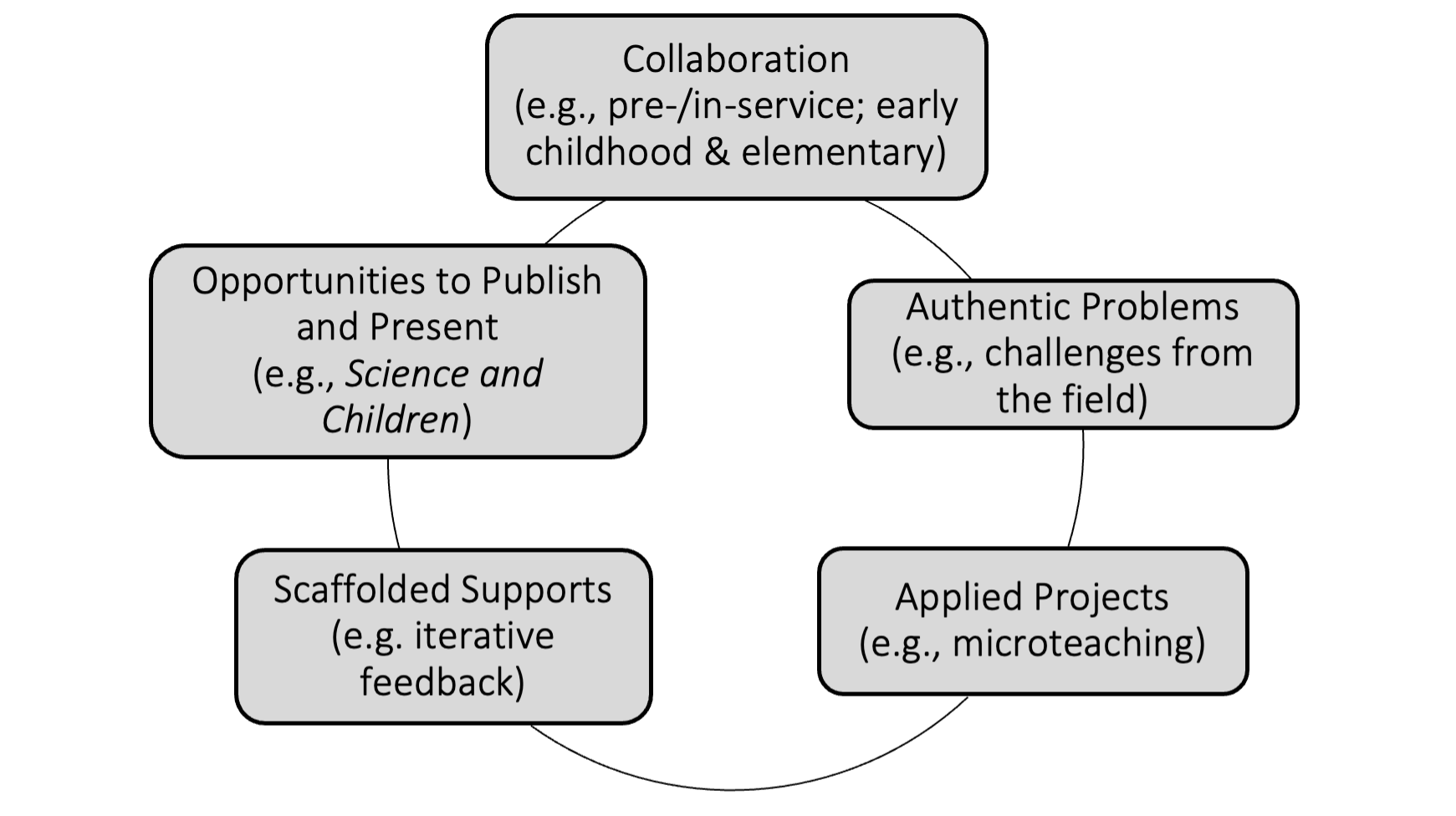Appendix A: Starting Your Own Early/Elementary STEM Collaboration
Building a collaboration with classroom teachers has transformed our STEM education courses, because it provides opportunities for pre-service teachers to engage in authentic learning experiences with elementary students. We recommend that other STEM educators build collaborations of their own. One of our articles, entitled, Making Stone Soup: A Collaborative Approach to Integrated STEM (in press) describes our collaboration briefly and includes tips on starting new collaborations like ours. Suggestions to guide the start-up of a new collaboration, or to adapt an existing STEM education teacher education program include:
- Collaborate. Seek out partners who might bring expertise that you do not have (e.g., university faculty in mathematics department), who could bring authentic challenges to the project (e.g., a local school or teacher looking to infuse more STEM), or who connect to families or communities (e.g., the local library doing STEM nights). Some work might need to be done to bridge early childhood and elementary programs, if they come from different philosophical traditions, as is the case at our institution. Note, for example, this quote related to math teaching, “all-encompassing recommendations that instruction should be entirely ‘student centered’ or ‘teacher directed’ are not supported by research” (NMP, 2008, p. xxii).
- Be flexible. We have learned the importance of being flexible and learning from participants. Feedback from students, pre-service teachers, and teachers have made our project better each year.
- Make it yours. Make a collaborative project suit your own needs, pre-service teachers, students, teacher partners, and contexts. Partnering with schools isn’t possible? What about local museums? Does your pre-service program have a different major assignment in your science or STEM class? No problem! How could your assignment connect to a real problem of practice? Could you do video calls with a classroom instead of visiting? What professional collaborative opportunities could there be?
Components of the Approach
After experiencing the powerful transformation in our courses, we sought to identify the primary elements of our collaboration that contributed to its success. The resulting framework consists of five components shown in Figure 1.

Collaboration
- Defined: working together with others towards a common purpose. Our collaboration has been between stakeholders, such as practicing teachers, university faculty, preservice teacher candidates, and the community. But others could be involved, such as families. Early and elementary education have different philosophies and traditions, but teaching STEM and integrated STEM may provide space in which early childhood and elementary education teacher preparation programs can find common ground.
- Purpose: learn from each other, draw on strengths, broaden perceptions of STEM education
Applied projects
- Defined: applied teaching experiences (microteaching) with real early/elementary students that build on authentic problems from the field
- Purpose: increase motivation, allow for application of knowledge learned in course
Authentic problems
- Defined: applied teaching experiences (microteaching) with real early/elementary students that build on authentic problems from the field
- Purpose: increase motivation, allow for application of knowledge learned in course
Scaffolded Supports
- Defined: scaffolded supports for teacher candidates as they learn, including feedback and multiple stages, and extra support as needed
- Purpose: provide support for teacher candidates as they tackle a challenging project
Opportunities to Publish and Present
- Defined: professionalization opportunities for pre-service teachers and teachers in the form of co-presenting at conferences, co-authoring papers, and co-developing resources (see list of publications below)
- Purpose: pre-service teachers see their role in the field, how publications and research impact practice, support their later employment
Publications
Below is a sample of our EC/Elementary STEM Collaboration project’s publications since it started in 2016/2017. Many of the co-authors include teachers and pre-service teacher candidates. See an updated list at our website.
*student co-authors
**teacher co-authors
Practitioner Articles
- Lange, A., Rice, E.,* Howe, N.,** & Tian, Q.* (in press). A Light Challenge: First Graders Engineer an Obstacle Course with Flashlights. Science and Children.
- Robertson, L., Lange, A. A., Price, J., Lowery, A.,** Lester, L.,** Tian, Q.*, & Nivens, R., (in press). Making Stone Soup: A Collaborative Approach to Integrated STEM. Science and Children.
- Lange, A. A., Lodien, D.,** & Lowe, A.* (2019). The worms are dancing! An integrated learning experience with preschoolers. Science and Children. Apr/May, 41-45.
- Robertson, L., Dunlap, E.,* Nivens, R., & Barnett, K.** (2019). Sailing Into Integration: Planning and implementing integrated 5E learning cycles. Science and Children, 57(1), 61-67.
Journal Articles, Peer-Reviewed
- Robertson, L., Nivens, R., & Lange, A. A. (2020). Tackling Integrated STEM in Elementary Education: A Collaborative Approach. International Association of Laboratory Schools. https://www.ecstemlab.com/uploads/4/0/3/5/40359017/robertson_nivens_lange_2020_stem_collab_ials.pdf
